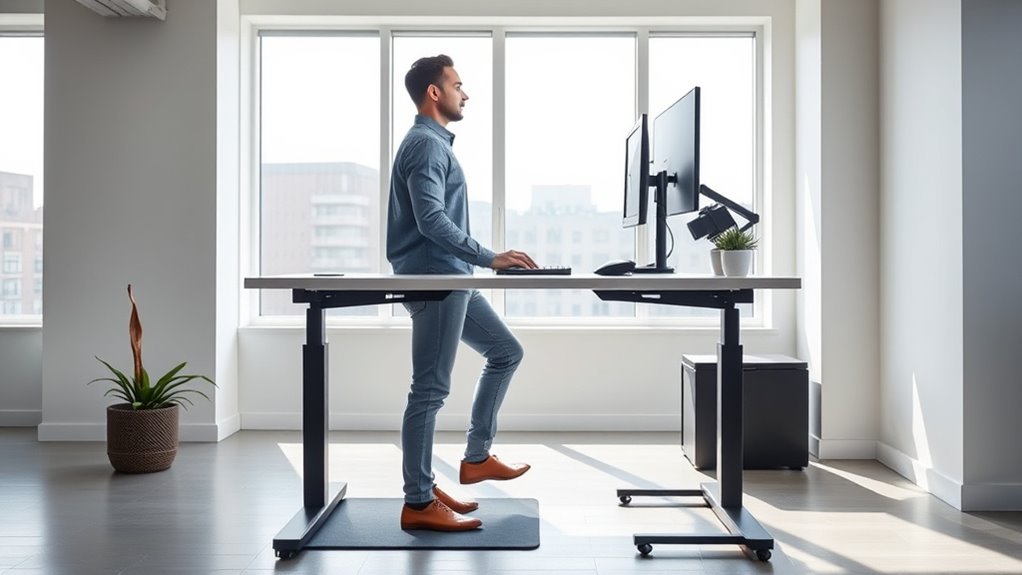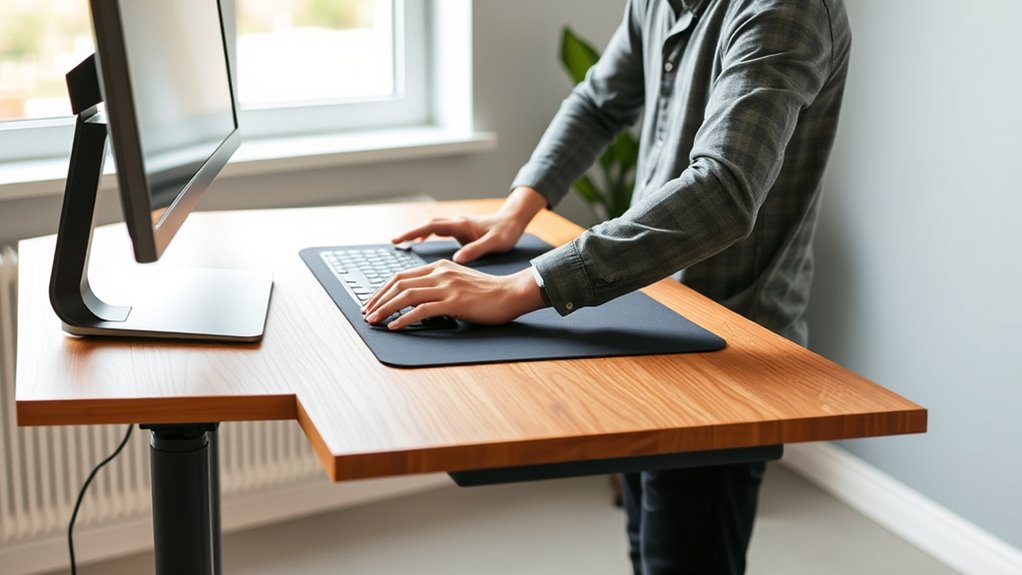To avoid common ergonomic mistakes at your standing desk, prioritize proper foot placement by keeping your feet flat and shoulder-width apart, and use a footrest if necessary. Adjust your desk height so your elbows are bent at about 90° and your wrists stay neutral. Maintain good posture by relaxing your shoulders, keeping your head aligned, and engaging your core. Remember to take regular breaks and shift positions—continuing to improve your setup will keep you comfortable and injury-free.
Key Takeaways
- Ensure your desk height allows elbows to stay close to 90° and wrists remain neutral during work.
- Keep feet flat on the ground or use a footrest to avoid uneven weight distribution.
- Maintain proper posture by keeping shoulders relaxed, chest open, and head aligned with the spine.
- Take regular breaks every 30 minutes to stretch, shift, or walk, preventing stiffness and fatigue.
- Regularly check and adjust your standing position for comfort and proper alignment throughout the day.

Standing desk ergonomics is essential for maintaining comfort and preventing injury while working. When you’re standing at your desk, small details like foot positioning and desk height can make a big difference in how you feel during and after your workday. Proper foot placement helps distribute your weight evenly, reducing strain on your legs and lower back. Keep your feet flat on the floor, shoulder-width apart, and avoid crossing your legs, which can lead to misalignment and discomfort over time. If your feet don’t reach the ground comfortably, consider using a footrest to provide stability and support. This small adjustment prevents you from leaning or tilting your pelvis, which can cause long-term musculoskeletal issues.
Getting your desk height right is equally important. When your desk is too high or too low, you risk putting unnecessary stress on your neck, shoulders, and arms. Your elbows should be close to your sides and bent at roughly a 90-degree angle, with your wrists in a neutral position. Adjust the height of your standing desk so that your forearms are parallel to the ground when typing or using a mouse. This positioning helps minimize fatigue and strain. If your desk’s height isn’t adjustable, you can use platforms or risers to fine-tune the level, ensuring your workspace promotes good posture.
Another common mistake is neglecting to check your standing posture regularly. It’s tempting to assume that simply standing is enough, but poor posture can still lead to discomfort. Keep your shoulders relaxed, your chest open, and avoid leaning forward or arching your back. Engage your core muscles to support your spine, and shift your weight slightly from one foot to the other every so often to prevent fatigue. Also, be mindful of your head position; keep it aligned with your spine, avoiding craning forward to look at your screen. Incorporating proper ergonomics into your routine can significantly improve comfort and reduce stress on your body.
In addition, take frequent breaks to sit or move around. Standing for long periods without movement can cause fatigue and stiffness, so set a timer to remind yourself to sit, stretch, or walk every 30 minutes. Incorporating these ergonomic practices into your routine not only boosts comfort but also helps prevent long-term injuries. Fine-tuning your foot positioning and desk height, along with maintaining awareness of your posture, ensures your standing desk setup works for you, not against you.
Frequently Asked Questions
How Often Should I Change Positions While Using a Standing Desk?
You should change positions regularly when using a standing desk to prevent fatigue and promote good posture. Aim for posture adjustments every 30 to 60 minutes, shifting your stance or taking a brief sit-down. Keep your desk height properly adjusted to support neutral wrist and arm positions. These small changes help reduce strain, improve circulation, and keep you comfortable throughout your workday.
What Accessories Can Improve Standing Desk Ergonomics?
To improve your standing desk ergonomics, consider adding desk accessories that provide ergonomic enhancements. A footrest helps distribute your weight evenly, reducing fatigue. Anti-fatigue mats make standing more comfortable and reduce strain. A monitor stand or adjustable arm positions your screen at eye level, preventing neck strain. Keyboard trays and wrist rests promote proper hand posture. These accessories work together to create a more comfortable, healthy workspace, encouraging better posture and reducing discomfort.
Is It Better to Alternate Between Sitting and Standing Daily?
You should alternate between sitting and standing daily to improve your sit-stand balance and promote ergonomic variation. This approach helps prevent fatigue, reduces strain, and boosts productivity. By switching regularly, you avoid the pitfalls of prolonged sitting or standing, which can cause discomfort or injury. Incorporating ergonomic variation into your routine guarantees your body remains comfortable and healthy throughout the day.
How Do I Prevent Foot and Leg Fatigue at a Standing Desk?
To prevent foot and leg fatigue at a standing desk, you should prioritize foot support by using cushioned mats or supportive shoes. Make sure to alternate leg elevation by shifting your weight or using a footrest to reduce strain. Regularly changing your stance, taking breaks to sit, and stretching your legs also help keep fatigue at bay, ensuring comfort and better posture throughout your workday.
What Are Signs I’M Using My Standing Desk Incorrectly?
Did you know that poor posture can cause up to 80% of musculoskeletal issues? If you’re feeling persistent neck, shoulder, or back pain, you might be using your standing desk incorrectly. Signs include slouching, uneven weight distribution, or eyes not level with your screen. Pay attention to posture cues, and regularly adjust your desk height to make certain your monitor is at eye level and your shoulders are relaxed.
Conclusion
Remember, proper standing desk ergonomics can boost your comfort and productivity. Did you know that standing desks can reduce sedentary time by up to 90%? But avoid common mistakes like improper height or poor posture, which can lead to discomfort or injury. Stay mindful of your setup, take regular breaks, and listen to your body. Small adjustments make a big difference—so stand smart and work comfortably every day!









